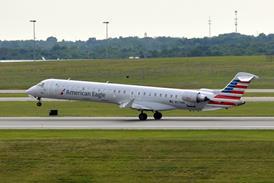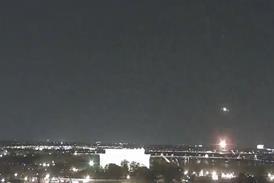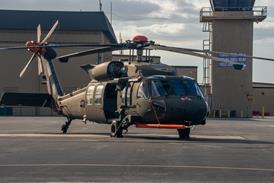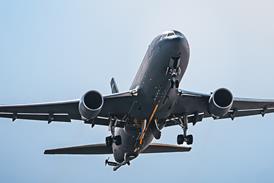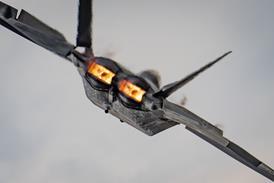America’s dream of getting astronauts to space and home again without having to suffer the embarrassment of sending them to Kazakhstan for a Russian Soyuz flight has taken an uncertain step forward. The drop-test of a US-built spaceplane concept appears to have validated its airworthiness, but its maker – Sierra Nevada – remains cagey about the extent of the damage done when its 1min glide from 12,500ft (3,810m) ended in a crash landing at Edwards Air Force Base in California.
Sierra Nevada space systems head Mark Sirangelo described the Dream Chaser’s flight as perfect, until a “landing gear anomaly” sent it skidding off the runway into the sand. In a briefing with journalists on the 26 October drop from an Erickson-operated Sikorsky S-64 Skycrane helicopter, Sirangelo said on 29 October that the left landing gear did not deploy, causing the unmanned craft to land on its left side in the dirt next to the runway. The craft, he said, was repairable and left with all its components in place, and the runway at NASA’s Dryden research centre suffered no damage.
However, when pressed to describe the landing in detail, Sirangelo would only say that it made “manoeuvres” and came to rest upright. A video of the flight released by Sierra Nevada ends as the Dream Chaser approaches touchdown, but does reveal that there were furry dice hanging from where the rearview mirror would be.
The nine-year-old Dream Chaser project has to date consumed around $300 million of NASA money. This is in addition to what Sirangelo describes as a similar amount put in by Sierra Nevada’s investors. Other lead beneficiaries of NASA’s $1.4 billion Commercial Crew Development programme, designed to help private companies fill the space transportation gap left by the retirement of the Space Shuttle in 2011, include Boeing and SpaceX, both of whom are developing traditional capsules.
Perhaps to highlight the sensitivity of NASA’s budget in Washington DC's current political environment, Sirangelo, in a 1h press conference, thanked – twice – the people in 30 US states who are working for Dream Chaser project partners. NASA itself highlights the fact that “there are 100 aerospace providers in 33 states to get American astronauts back into space on US-led spacecraft and rockets”.
But whatever the political tensions behind funding the so-called CCDev programme, the scheme is making progress. SpaceX has, with the help of $440 million from NASA, flown a cargo version of its Dragon capsule to the International Space Station, and returned it to Earth. The crewed variant will carry up to seven astronauts.
Boeing’s alternative has been subjected to drop tests over the Nevada desert.
Either of the capsules will be necessary to survive re-entry from deep space missions including to the Moon. However, while Dream Chaser would be limited to low-Earth orbit, it is retains the Shuttle-era vision of a runway landing, reusable transport craft – though in a vehicle about a third the size.
To that end, Sirangelo is keen to portray the October drop test as a success, even a great success, despite the “minor concern” of the failure of landing gear derived from the F-5 fighter, which will not feature on the orbit-capable vehicle currently being constructed with partner Lockheed Martin. “This is not the first time [that the] landing gear has had issues on aeroplanes that have gone on to be very successful,” says Sirangelo.
The vehicle that flew at Edwards on 26 October is not capable of orbital flight. However, it is essentially identical – in shape and size – to the craft that Sirangelo expects will fly atop an Atlas rocket in 2016, in fully autonomous mode, and then in 2017 with a human pilot.
One key component of the orbital vehicle, which is merely simulated for shape on the test craft, will be its thermal protection system. Though similar to the Space Shuttle’s – underlayer, ceramic tiles and then ablative coating with carbon-carbon patches on the hottest spots – Dream Chaser’s heat coat is, says Sirangelo, “three generations removed” from the protection that proved so challenging to maintain and whose failure doomed the crew of Columbia on re-entry in 2003.
Dream Chaser’s protection system, he adds, will be reusable, but will need to be replaced as part of scheduled maintenance more than once in each craft’s 30- to 40-mission service life.
The purpose of the test was to validate the airworthiness of the shape, which is very closely based on NASA’s HL-20 lifting body concept of the 1980s. All the computer models predicted that it would fly, but Sirangelo notes that this drop test was the first of a lifting body vehicle since the Space Shuttle programme’s aerodynamics mule, Enterprise, made its last outing – exactly 36 years ago.
Sirangelo compares this engineering test article (ETA) vehicle to Enterprise, including its short design life. The ETA was built for five flights, two in autonomous mode and three manned.
Fortunately, he says, the flight from 12,500ft was “rock solid” and provided so much data that a second autonomous flight, following repairs, may prove unnecessary. Sierra Nevada and NASA are still analysing the flight, but may opt to move straight to the three manned flight trials planned, from mid- to third quarter-2014.
Dream Chaser is to be optionally manned, to allow for uncrewed research flights or to maximise the number of seats available for use as a Space Station escape vehicle. In autonomous mode, as in the October drop test, Dream Chaser chooses its descent angle, finds the runway and lands automatically.
All of that went “perfectly” until the landing gear failed, says Sirangelo. After release from the helicopter, Dream Chaser entered a 50˚ nose-down dive to simulate re-entry flight and pulled up after about 10s to enter its glide phase. After 30-35s, the craft began searching for the runway, found it about 20s before contact and then slowed to its designed 160-163kts (296-301km/h) for touchdown, on the centreline.
At least outwardly, Sirangelo is unfazed by the fact that the final seconds turned out to be not so perfect. “It was a very successful day with an unfortunate anomaly,” he says.
Source: FlightGlobal.com


